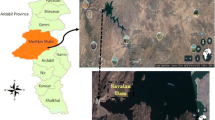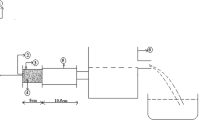Abstract
Internal erosion of dam’s embankments is a complex process and considered as the main cause of hydraulic works failure. Laboratory experiments provide a potential insight into the processes involved. Particles detachment from a core of earth and rock fill dams within a crack submitted to water seepage may lead to backward erosion which gradually progresses till forming a pipe. Clay of designed core must provide a quite good resistance against erosion, which depends on material and flow characteristics. The present study reports the results from hole erosion tests (HET) aiming to assess the erodibility of a clayey soil collected from a deposit by Tipaza (Algeria) and used in the core confection of an earthen dam. For this purpose, tests were performed under successive hydraulic loads and the pressure drop was measured as close as possible to the pipe edges. Hydrodynamic parameters effect on erosion rate of tested soil was investigated and the susceptibility of tested soil to erosion was addressed. A numerical simulation of turbulent flow in hole pipe using FEM was carried out to approach the hydrodynamic process occurring inside the hole and to compute shear stress acting along the wall. Numerical values of local shear stress were matched with analytical values and used to describe the area impacted by erosion and the hole radius evolve. Numerical results showed that the usual analytical evaluation of shear stress along the hole overestimates strongly the effect of seepage on the hole wall. Attempts are also made to assess the erodibility classification of tested soil from analytical and numerical results to estimate the deviation usually affecting the interpretation of HET.











Similar content being viewed by others
References
C.F. Wan, R. Fell, Laboratory tests on the rate of piping erosion of soils in embankment dams. Geotech Test J. 27:295–303 (2004) https://doi.org/10.1520/GTJ11903
J.J. Fry, Lessons on internal erosion in embankment dams from failures and physical models. Proc 8th Int Conf on Scour and Erosion, Oxford, UK, 12–15 September 2016. (CRC Press, 2016). http://eprints.hrwallingford.com/id/eprint/1059
Foster M, Fell R, Spannagle M (2000) The statistics of embankment dam failures and accidents. Can Geotech J 37(5):1000–1024. https://doi.org/10.1139/t00-030
Rönnqvist H, Viklander P (2014) Unified-plot approach for the assessment of internal erosion in embankment dams. Int J Geotech Eng 10(1):66–80. https://doi.org/10.1179/1939787915y.0000000002
Rönnqvist H, Fannin J, Viklander P (2014) On the use of empirical methods for assessment of filters in embankment dams. Géotech Lett 4(4):272–282. https://doi.org/10.1680/geolett.14.00055
Merritt WS, Letcher RA, Jakeman AJ (2003) A review of erosion and sediment transport models. Env Mod and Software 18:761–799. https://doi.org/10.1016/S1364-8152(03)00078-1
Knapen A, Poesen J, Govers G, Gyssels G, Nachtergaele J (2007) Resistance of soils to concentrated flow erosion: a review. Earth-SciRev 80:75–109. https://doi.org/10.1016/j.earscirev.2006.08.001
Elkholy M, Sharif Y, Chaudhry M, Imran J (2015) Effect of soil composition on piping erosion of earthen levees. J Hyd Res 53(4):478–487. https://doi.org/10.1080/00221686.2015.1026951
Ali Zomorodian SM, Moghadam MJ (2011) Investigation of effective parameters on the embankment dam filter behavior in simultaneous cracking in the core and filter. Geotech Geol Eng 29:637–644. https://doi.org/10.1007/s10706-011-9407-z
ICOLD. Assessment of the risk of internal erosion of water retaining structures: dams, dykes and levees. Bulletin.164 Int. COmmission on Large Dams. (2017). http://www.icold-cigb.org.
Briaud JL, Ting F, Chen HC, Cao Y, Han SW, Kwak K (2001) Erosion Function Apparatus for scour rate predictions. J Geot Geoenv Eng 127(2):105–113. https://doi.org/10.1061/(ASCE)1090-0241(2001)127:2(105)
Bonelli S, Brivois O (2008) The scaling law in the hole erosion test with a constant pressure drop. Int J Num Anal Meth Geomech 32:1573–1595. https://doi.org/10.1002/nag.683
Řiha J, Jandora J (2015) Pressure conditions in the hole erosion test. Can Geotech J 52:114–119. https://doi.org/10.1139/cgj-2013-0474
Fattahi S, Soroush A, Shourijeh P (2017) The hole erosion test: a comparison of interpretation methods. Geot Testing J 40(3):494–505. https://doi.org/10.1520/GTJ20160069
Delgado R, Poyatos JM, Osorio F (2012) Internal erosion of Clayey soils protected by granular filters. La Houille Blanche 4–5:42–47. https://doi.org/10.1051/lhb/2012029
Wan CF, Fell R (2002) Investigation of internal erosion and piping of soils in embankment dams by the slot erosion test and the hole erosion test. UNICIV report R-412, University of New South Wales, Sydney, Australia, ISSN 0077 880X
Haghighi I, Chevalier C, Duc M, Guédon S, Reiffsteck P (2013) Improvement of hole erosion test and results on reference soils. J Geotech and Geoenv Eng 139(2):330–339. https://doi.org/10.1061/(asce)gt.1943-5606.0000747
Walder J (2015) Dimensionless erosion laws for cohesive sediment. J Hyd Eng 142(2):1–13. https://doi.org/10.1061/(asce)hy.1943-7900.0001068
Hanson GJ, Simon A (2001) Erodibility of cohesive streambeds in the loess area of the Midwestern USA. Hydrol Process 15(1):23–38. https://doi.org/10.1002/hyp.149
Gerasimov A (2006) Modeling turbulent flows with Fluent. Ansys Inc, Europe
Benaissa K, Parron Vera MA, Rubio Cintas MD, Dubujet P, Khamlichi A, Bezzazi M, El Bakkali L (2012) Predicting initial erosion during the hole erosion test by using turbulent flow CFD simulation. Applied Math Mod 36:3359–3370
Launder BE, Spalding DB (1972) Lectures in Mathematical Models of Turbulence, Academic Press, London, England. https://doi.org/10.1002/zamm.19730530619
Yakhot V, Orszag SA (1986) Renormalization group analysis of turbulence: I-Basic theory. J Sci Comput 1(1):1–51. https://doi.org/10.1007/BF01061452
ANSYS Fluent ANSYS Users Guide, ANSYS Inc. (2014)
Kim J, Moin P, Moser R (1987) Turbulence statistics in fully developed channel flow at low Reynolds number. J Fluid Mech 177:133–166. https://doi.org/10.1017/s0022112087000892
Antonia RA, Kim J, Browne LWB (1991) Some characteristics of small-scale turbulence in a turbulent duct flow. J Fluid Mech 233:369–388. https://doi.org/10.1017/s0022112091000526
Acknowledgements
This research was supported by the National Found of Research – DGRSDT, Algerian Ministry of High Education.
Author information
Authors and Affiliations
Corresponding author
Additional information
Publisher's Note
Springer Nature remains neutral with regard to jurisdictional claims in published maps and institutional affiliations.
Rights and permissions
About this article
Cite this article
Kadri, M., Benamar, A. Erosion Process of a Core Clay in Earth and Rockfill Dams: Laboratory Experiments and Numerical Modelling. Indian Geotech J 51, 1310–1318 (2021). https://doi.org/10.1007/s40098-021-00531-w
Received:
Accepted:
Published:
Issue Date:
DOI: https://doi.org/10.1007/s40098-021-00531-w




